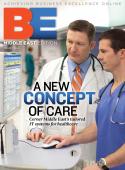Good medicineInvestments in facilities, training and technology are helping Jewish General Hospital in Montreal to remain in the forefront of medicine in Canada, Philippe Castiel tells Ruari McCallion.ThereÔÇÖs always the danger that the presence of a renowned institution can overshadow neighboring organizations, but that doesnÔÇÖt seem to be a problem for MontrealÔÇÖs Jewish General Hospital (JGH). It cooperates well with nearby McGill University Health Centre in teaching and has been hugely successful in attracting and retaining specialist staff. Something in excess of 50 percent of radio-oncology graduates from the four centers of excellence in the Montreal region sign up at JGH. Part of that appeal may well be the extensive construction and renovation programs the hospital is currently undertaking.ÔÇ£Our radio-oncology expansion project was started in March 2007, and we expect completion in 2008,ÔÇØ says Philippe Castiel, JGHÔÇÖs director of informatics, who is responsible for all the hospitalÔÇÖs major construction projects. ÔÇ£ItÔÇÖs a CAN$30 million project, which will provide us with three new bunkers, two new linear accelerators, a simulator and a new brachytherapy suite. All the radiotherapy facilities are located underground because of the unavoidable radiation, but the building has been designed to enable natural light to penetrate to the basement.ÔÇØ Closure of the main hospital entrance during construction is inconvenient, but a new atrium and entrance hall will make a very clear statement of what JGH is today: a modern hospital with its face very firmly set to the future. While a timescale of just 18 months may seem somewhat ambitious, Castiel is confident it will be completed on budget and on timeÔÇöhe has done it before. ÔÇ£Construction on the new Segal Cancer Centre started in 2004 and was finished one week ahead of schedule, in just under 13 months,ÔÇØ he says. ÔÇ£We added eight floors and expanded the ambulatory care building by 180,000 square feet. It was a $40 million design and build undertaking, with project management by a joint venture between Pomerleau and Verrault, two of QuebecÔÇÖs largest contractors. We managed the subcontractors directly, including Lambert-Sorrel, which handled the plumbing and heating contracts.ÔÇØThe approach worked, clearly, but design and build isnÔÇÖt always the most efficient way of operating major construction projects. Other organizations have found that design first, identify all the savings from pooled expertise, then careful scheduling of construction can keep costs, inconvenience and variations to a minimum. ÔÇ£We canÔÇÖt take the hospital offline while we complete these projects; time is an important factor,ÔÇØ says Castiel. ÔÇ£This is the process that the Ministry of Health had pursued in the traditional mode, where organizations design, build and operate. The Segal project was originally scheduled for 30 months; in the event, it took 13 months less one week. It has been an outstanding project for us and for the Ministry of Health and has raised confidence for further capital projects.ÔÇØ And they are important for the future development of JGH.ÔÇ£The promise of new build is important for attracting staff. To retain them, we need the actuality,ÔÇØ he explains. And not only for its own sake. ÔÇ£The number one issue facing hospitals today is prevention of infections, like MRSA (the methicillin-resistant ÔÇÿsuperbugÔÇÖ) and C. dificile. The ultimate way to minimize infection is to keep people away from each other. The expansion in the area of the hospital will not create additional bed capacity; it will stay the same at around 637 beds. What we will be able to do is redistribute, converting two-bed rooms to private and four-bed accommodations to two-bed, but at the same time retain the infrastructure that will enable us to offer the authorities over 200 beds for disasters and emergencies.ÔÇØJGH started life as a facility aimed at the healthcare needs of the Jewish community in MontrealÔÇödiscrimination was a global reality in the 1930s. Today its mission is ÔÇ£care for allÔÇØ; itÔÇÖs a leading acute care and obstetrics institute, a teaching hospital with a specialty in emergency room (ER). ÔÇ£We operate one of only a very few accredited courses recognized for ER by the Royal College of Surgeons in Quebec. We are recognized for our efficiency; the management has put a lot of emphasis on it for a number of years. Thirteen of the 27 physicians in our ER have the ER specialty, and around 90 percent of our physicians are based here full time. We have more than 30 specialties altogether, including obstetrics and gynecology, neonatology, cardiology and cancer. We are designated as a ÔÇÿmega-researchÔÇÖ center for Canada and Quebec, which attracts around CAN$45 million in subventions annually and maintains over 500 jobs. We have excellent reviews from FRSQ (Quebec Foundation for Research in Health), and we receive numerous grants, including from the US Army and the Canadian Institute of Health Research.ÔÇØ The standing of the hospital and its current and planned expansion program help it to achieve an astonishing 92 percent staff retention rate. Specific sectors, such as nursing, are targeted for development, with mentoring, career guidance and support for students. ÔÇ£Medicine has evolved tremendously and the infrastructure hasnÔÇÖt kept pace,ÔÇØ says Castiel. ÔÇ£We have to renovate, upgrade and expand, and one of our strengths is the involvement of business leaders and specialists in our committees. We have the CEOs of two of CanadaÔÇÖs biggest construction companies on our buildings committee, who volunteer their time and expertise to help the hospital build on its success. Over the next five years, MontrealÔÇÖs population is expected to grow at double the rate of the rest of Canada, with a higher than average birthrate; that will put pressure on obstetrics. At the other end of the scale, an aging population will require more resources in geriatrics. WeÔÇÖre introducing more technology, such as electronic patient records and voice recognition for note dictation from Crescendo Systems. WeÔÇÖre partnering with IBM for RFID and its subsidiary, Symbol, for Wi-Fi; with BellCanada for Wi-Fi /PBX interface; and with ConnectSol for the patient/healthcare professional interface. Technology and additional space will enable us to keep pace with QuebecÔÇÖs health demands.ÔÇØ









